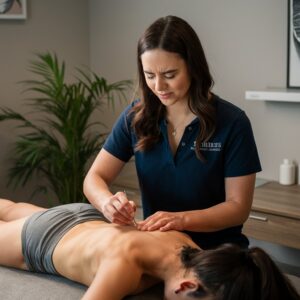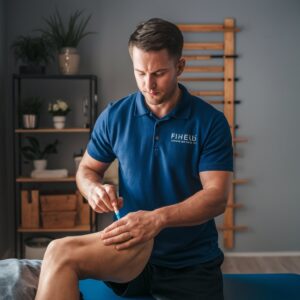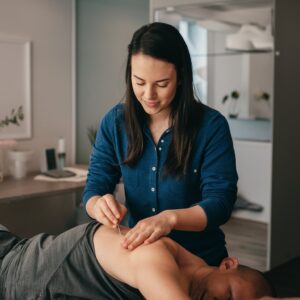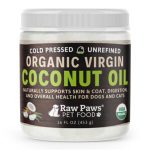Enhancing Manual Therapy with Dry Needling
Physical therapists, chiropractors, and other medical professionals use dry needling as an effective therapeutic technique for addressing musculoskeletal pain and movement disorders. Tiny needles are strategically inserted into targeted pressure points on the body, relieving stress and pain. Dry needling is grounded in Western medicine and neurophysiology, distinguishing it from acupuncture, rooted in traditional Chinese medicine.
The primary goal of dry needling is to locate and address trigger points and hyperirritable areas in skeletal muscle that may result in noticeable nodules or tense bands. These trigger points can often cause localised and referred pain, restricted movement, and muscle weakness. Nevertheless, dry needling provides a glimmer of hope and positivity by alleviating pain and enhancing functional ability by releasing these trigger points.
When it comes to comprehensive treatment plans that include physical therapy, exercise, and other forms of treatment, dry needling is a safe and effective procedure that plays a crucial role. This task should only be carried out by highly trained and certified healthcare professionals who have undergone specialised training to ensure the safety and well-being of the patient. You can be confident that patients will receive clear and thorough information regarding the potential advantages and risks of the procedure before undergoing therapy.
This approach is effective in addressing musculoskeletal pain and can be combined with other manual therapy interventions.
Main Points
- Dry needling is a highly effective method for alleviating pain and enhancing functionality. It entails the precise insertion of thin needles into specific muscle trigger points.
- The science behind dry needling revolves around stimulating the nervous system and encouraging the release of natural pain relievers to alleviate muscle tension and enhance blood circulation.
- Combining dry needling with manual therapy can significantly improve treatment results by effectively targeting the soft tissue pain associated with musculoskeletal pain.
- Utilising dry needling techniques, muscle trigger points are effectively targeted to alleviate pain and enhance the range of motion. This makes it an invaluable resource for effectively managing muscle pain.
- Musculoskeletal pain can be effectively addressed by incorporating dry needling alongside joint mobilisation techniques. This approach targets the affected tissue and joint structures, providing a comprehensive treatment solution.
 The Science Behind Dry Needling: How it Works to Relieve pain
The Science Behind Dry Needling: How it Works to Relieve pain
Local Twitch Response and Muscle Relaxation
A needle inserted into a trigger point can elicit a local twitch reaction, causing the muscles surrounding the needle to contract reflexively. This twitch reaction is thought to help relieve muscle tension and break the cycle of dysfunction and discomfort.
Exploring the Benefits of Pain Relief and Neurophysiological Effects
When the needle is inserted, it can stimulate the body’s natural painkillers, known as endorphins. This leads to quick pain relief and a decrease in muscle soreness. In addition, dry needling can potentially impact the nervous system by altering sensory nerve activity and reducing the transmission of pain signals to the brain. This can help desensitise the nervous system and minimise the sensation of pain.
Understanding the Process of Local Blood Flow and Tissue Healing
Dry needling induces microtrauma at the insertion site, leading to enhanced local blood flow and improved tissue repair. Enhancing the oxygen and nutrient levels in the area while eliminating metabolic waste products can have a positive impact. Understanding the science behind dry needling allows for a deeper appreciation of its impact on the body, such as reducing pain and improving overall function.
Integrating Dry Needling with Manual Therapy: Enhancing Treatment Outcomes
The effectiveness of treating musculoskeletal pain and dysfunction can be enhanced by incorporating manual therapy techniques like joint mobilisation, soft tissue mobilisation, and stretching dry needling. Manual therapy aims to restore the natural movement of joints and soft tissues, while dry needling relieves trigger points and muscle tension. By combining these approaches, healthcare practitioners can effectively tackle both the mechanical and neuromuscular aspects of pain and movement limitations.
Suppose a patient is experiencing symptoms of shoulder pain and limited mobility due to a rotator cuff injury. In that case, a physical therapist may use manual techniques to improve joint mobility. Additionally, they may use dry needling to target trigger points in the muscles and provide relief. By combining both methods, you can experience enhanced pain relief, increased range of motion, and improved functional activities. In addition, the combination of dry needling and manual therapy can help prolong the benefits of treatment by addressing both the root cause of musculoskeletal dysfunction and the resulting pain.
Healthcare providers should understand manual therapy and dry-needling techniques to integrate them into treatment programs successfully. Just as crucial is educating patients, as it plays a vital role in helping individuals grasp these therapies’ purpose and anticipated outcomes. By integrating these treatments, healthcare practitioners can provide comprehensive therapy to patients experiencing musculoskeletal discomfort.
Targeting Trigger Points: Using Dry Needling for Muscle Pain Relief
Utilising dry needling techniques, muscle trigger points can be effectively targeted to alleviate muscle discomfort and dysfunction. Palpable nodules or taut bands often accompany hyperirritable areas in skeletal muscle. These websites may lead to localised and transferred discomfort, limited range of motion, and muscle atrophy.
Healthcare providers are crucial in ensuring a safe and effective dry-needling procedure. By strategically inserting tiny needles into specific trigger points, a local twitch response is triggered, releasing muscle tension and relieving patients. For instance, if a patient is experiencing low back pain that worsens with prolonged sitting, a physical therapist’s professional knowledge can help identify trigger points in the paraspinal muscles that may be causing the discomfort. A skilled practitioner can effectively relieve pain and tension by utilising dry-needling techniques in these specific areas.
In addition, utilising dry needling to address trigger points can improve muscle flexibility and function, allowing individuals to experience greater mobility and perform daily tasks with less discomfort. An in-depth assessment by healthcare professionals is essential to pinpoint trigger points and determine if dry needling is a suitable treatment option. It is important to provide patients with clear information about what they can expect during their dry needling therapy, including any possible side effects or warnings.
Healthcare providers have the expertise to address muscular discomfort and dysfunction by focusing on trigger points through dry needling, a therapy that has been proven effective.
 Combining Dry Needling with Joint Mobilization: Addressing Musculoskeletal Pain
Combining Dry Needling with Joint Mobilization: Addressing Musculoskeletal Pain
Combining joint mobilisation procedures with dry needling can effectively address musculoskeletal pain and movement limitations by targeting trigger points within muscles. Joint mobilisation involves applying precise pressures to a joint to restore its natural range of motion and provide relief from pain. By incorporating physical needling into joint mobilisation therapies, healthcare professionals can efficiently address both the muscular and articular components of musculoskeletal disorders.
For example, if a patient is suffering from knee pain due to patellofemoral dysfunction, a physical therapist can use joint mobilisation techniques to improve the movement of the patella. In addition, they can use dry needling to relieve trigger points in the quadriceps muscles. This comprehensive approach can alleviate discomfort and improve functional activities like walking, climbing stairs, and squatting. By addressing the joint and muscular components of dysfunction, healthcare practitioners can enhance patient care and provide a more comprehensive approach.
Healthcare providers should thoroughly understand joint mobilisation and dry-needling procedures to effectively integrate them into treatment programs. Equally crucial is educating patients, encouraging them to care for themselves and prioritising their long-term well-being. It assists individuals in comprehending the rationale behind these interventions and the anticipated treatment results. By incorporating these methodologies, medical professionals can provide a more comprehensive approach to treating individuals with musculoskeletal discomfort. This approach emphasises a dedication to their patients’ long-term health and well-being.
Addressing Neuropathic Pain: The Role of Dry Needling in Nerve Pain Management
Gaining Insight into Neuropathic Pain
Neuropathic pain is a complex condition that occurs when the neurological system is damaged or impaired. These symptoms can cause shooting or burning sensations, numbness, or tingling. Neuropathic pain trigger points can be located either along nerve pathways or in muscles supplied by the affected nerves.
Dealing with Sciatica through Dry Needling
For example, people with sciatica may suffer from neuropathic pain caused by compression or irritation of the sciatic nerve. By strategically identifying and treating specific trigger points along the sciatic nerve pathway, skilled healthcare practitioners can effectively alleviate distressing symptoms like leg pain and numbness. This method can alleviate neuropathic pain and enhance functionality by relieving tension in nerve trigger points.
Maximising the Benefits of Dry Needling for Nerve Pain Relief
Healthcare providers need to have a thorough understanding of nerve anatomy and neuropathic pain syndromes to effectively use dry needling to manage nerve pain. They should also provide patients with comprehensive information about the treatment process and any potential risks or precautions that may be associated with dry needling on nerve-related trigger points. Healthcare providers have the expertise to effectively address nerve-related symptoms by using dry needling to target neuropathic pain.
 Patient Education and Safety: Exploring the Benefits and Risks of Dry Needling in Manual Therapy
Patient Education and Safety: Exploring the Benefits and Risks of Dry Needling in Manual Therapy
Patient education is essential when incorporating dry needling into manual therapy treatments. It is crucial for individuals undergoing dry needling to have a thorough understanding of the therapy’s potential benefits and risks. Healthcare providers should prioritise dedicating ample time to explaining the intricacies of dry needling, offering a thorough explanation of the treatment procedure, and openly discussing any potential adverse effects, such as temporary discomfort or discolouration at the needle insertion sites.
In addition, educating patients about the safety precautions related to dry needling is essential. It is important to avoid strenuous physical activity immediately after the procedure and promptly notify the healthcare provider of any unusual or prolonged symptoms. Patients must understand that dry needling can be a valuable treatment option for musculoskeletal discomfort, but it may not suit everyone or every condition. Healthcare providers can enhance patient comfort during sessions by improving patient education on dry needling and empowering them to make well-informed decisions regarding their treatment options. This, in turn, can effectively reduce anxiety and significantly improve the overall treatment experience.
In addition, it is crucial to foster transparent and open communication between patients and healthcare professionals to address any concerns or questions related to dry needling effectively. Patient education is crucial for ensuring safety and achieving positive outcomes when incorporating dry needling into manual therapy procedures. In manual treatment strategies, dry needling is a highly advantageous method for addressing musculoskeletal pain and movement limitations.
Healthcare practitioners can enhance patients’ care by directing their attention towards trigger points within muscles and incorporating this technique with other manual therapy procedures, such as joint mobilisation. Moreover, dry needling can precisely focus on trigger points associated with nerve damage, providing relief from neuropathic pain. Ensuring that patients have access to thorough information is crucial in helping them understand the potential benefits and limitations of dry needling as part of their treatment plan.
A deep understanding of the mechanics and patient safety concerns is crucial when incorporating dry needling into manual therapy techniques to relieve musculoskeletal pain effectively.
Could you please explain what dry needling is?
Manual therapists, including physical therapists and chiropractors, use dry needling to address musculoskeletal pain and movement limitations. This procedure entails inserting fine needles into specific areas of muscle tension or trigger points, prompting the body to initiate a healing process.
Could you please explain how dry needling works?
Dry needling is all about targeting those pesky trigger points. These trigger points are annoying hyperirritable spots in the skeletal muscle, often accompanied by palpable nodules in taut bands of muscle fibres. Strategically inserting a needle into these trigger points can effectively release tension and promote better blood flow to the area, reducing pain and improving comfort overall.
Are dry needling and acupuncture considered to be the same thing?
Although dry needling and acupuncture utilise thin needles, they are distinct techniques based on separate principles. Acupuncture is rooted in ancient Chinese medicine and aims to rebalance the body’s energy flow, known as qi, by targeting specific meridians. On the other hand, dry needling follows Western medicine principles and focuses on addressing particular musculoskeletal problems.
Which conditions can be alleviated through dry needling?
Dry needling is an effective treatment option for various musculoskeletal conditions. These conditions may include neck, back, shoulder, hip, knee, and headaches, among others. In addition, it can effectively target muscle tightness, joint stiffness, and movement impairments.
Is dry needling considered safe?
Dry needling is generally regarded as safe when performed by a skilled and licensed manual therapist. However, like any medical procedure, there are potential risks and side effects to consider. These may include bruising, soreness, and, in rare cases, infection. It is crucial to receive treatment from a skilled and seasoned practitioner.
What is the usual number of dry needling sessions required?
The number of dry-needling sessions required may differ based on the individual and the specific condition being addressed. Individuals may notice considerable improvement following a single session, while others may need multiple sessions to achieve their desired results. A skilled therapist can assist you in navigating the suggested treatment plan that aligns with your specific requirements.
References:
- Trigger Point Dry Needling. https://www.strattonspine.com/services/trigger-point-dry-needling/
- Health Benefits of Physiotherapy | How We Can Help You. https://www.corefitness.com.sg/benefits-of-physiotherapy-clinical-pilates/
Brought To You By:
The Article: Integration of Dry Needling in Manual Therapy appeared first on Dry Needling Clayton-le-Woods Preston
The Article Dry Needling & Manual Therapy appeared first on https://mcrtherapies.com
The Article Dry Needling & Manual Therapy Was Found On https://limitsofstrategy.com
The Article Dry Needling & Manual Therapy First Appeared ON
: https://ad4sc.com



This post brings to light some fascinating aspects of dry needling and its role in enhancing treatment for musculoskeletal pain. As someone who has experienced both manual therapy and dry needling as part of a holistic treatment plan, I can personally attest to the transformative effects it can have on recovery and mobility.
It’s great to hear about your personal experience with dry needling and manual therapy. It’s always interesting to see how these techniques can complement each other in a holistic treatment plan.
I appreciate the exploration of dry needling within the realm of manual therapy. While it’s clear that many practitioners find value in this technique, I can’t help but reflect on the potential limitations and the need for a comprehensive approach to musculoskeletal pain management.
I find the discussion on enhancing manual therapy with dry needling particularly compelling, especially as someone who has personally experienced the transformative effects of this technique. My journey with chronic muscle pain led me to seek various treatments, and I can attest to the effectiveness of dry needling in addressing those pesky trigger points that seemed impossibly resistant to relief.
I really appreciate you sharing your experience with dry needling—it’s always refreshing to hear about real people and their journeys with treatment. Chronic muscle pain can be such a frustrating challenge, so it’s great to know that you’ve found relief through this technique.
It’s fascinating to explore the realm of dry needling as a complementary therapeutic technique, especially as it intertwines with both modern medical practices and our deeper understanding of body mechanics. The distinction you made between dry needling and acupuncture is crucial, highlighting how western therapies often draw from rigorous scientific inquiry while still addressing traditional holistic concepts.
You bring up some great points about dry needling and its role in the broader landscape of therapeutic practices. I’ve personally found it interesting how these therapies sometimes sit at the intersection of innovation and tradition. The scientific approach of dry needling, particularly in how it engages with muscle anatomy and physiology, really does reflect a more modern understanding of body mechanics, which I find refreshing when compared to the more established techniques in traditional practices like acupuncture.
You make an excellent observation about the interplay between innovation and tradition in therapeutic practices like dry needling and acupuncture. It’s interesting how both approaches have their unique roots yet aim to offer relief and support healing. I’ve often thought about how integrating traditional wisdom with modern science can enhance our understanding and treatment of pain.
It’s fascinating to see how dry needling is bridging the gap between traditional techniques and modern science. I’ve personally experienced the benefits of dry needling in conjunction with physical therapy, and it truly felt like unlocking a new level of mobility and comfort. The way it targets those pesky trigger points is remarkable, almost like a reset for my muscles.
It’s interesting to see how dry needling has gained traction alongside other manual therapy techniques. While the distinctions between dry needling and acupuncture are often emphasized, I find it fascinating to think about the underlying principles they share. Both approaches aim to alleviate pain, but from such different cultural and philosophical backgrounds.
This is such an interesting topic! I’ve always found the distinction between dry needling and acupuncture fascinating. It’s intriguing how both techniques involve needles but are rooted in such different philosophies of medicine. I’ve tried dry needling for chronic back pain, and the relief I experienced was remarkable. It felt like my therapist was able to pinpoint those stubborn trigger points in a way that manual therapy alone couldn’t achieve.
I totally get what you’re saying about the distinction between dry needling and acupuncture. It’s fascinating how each technique has its own philosophy and approach to healing. While dry needling is often more focused on the anatomical aspects, targeting trigger points to relieve muscle tension, acupuncture tends to encompass a broader view with its roots in traditional Chinese medicine, aiming to balance the body’s energy.